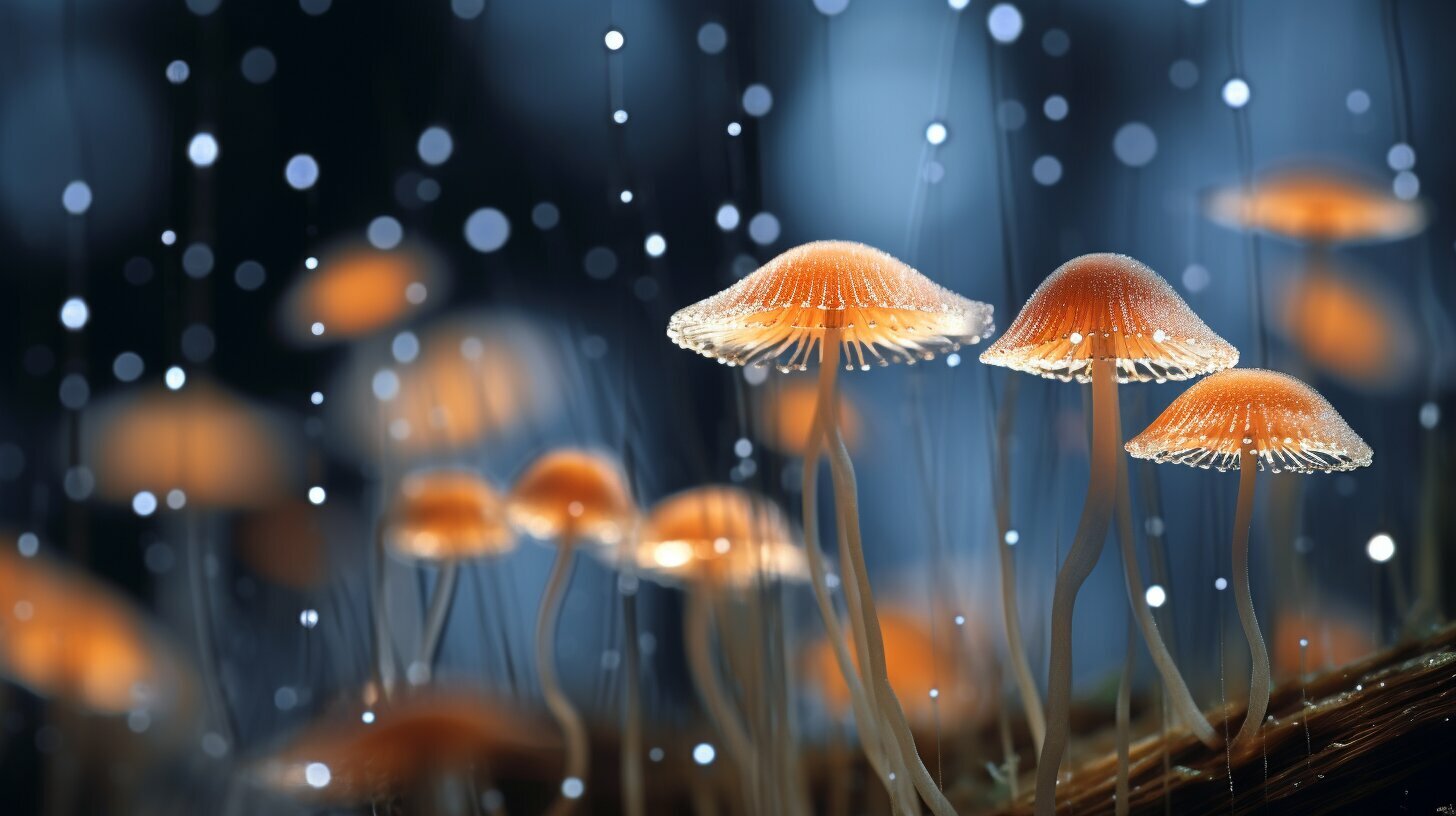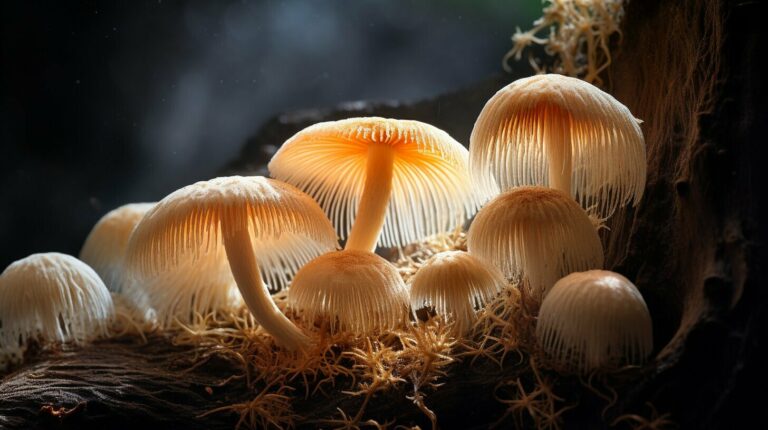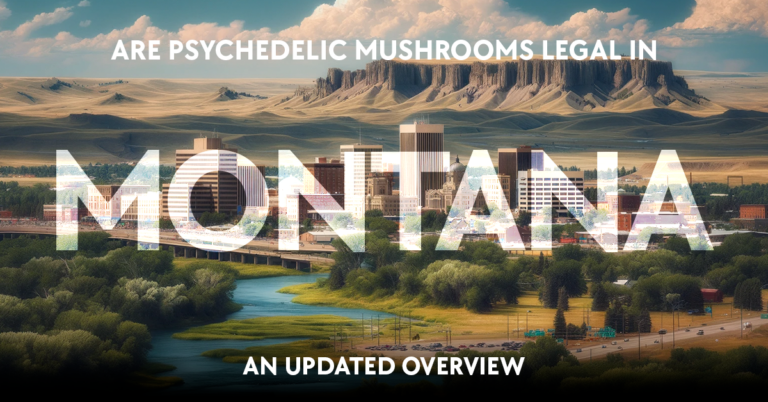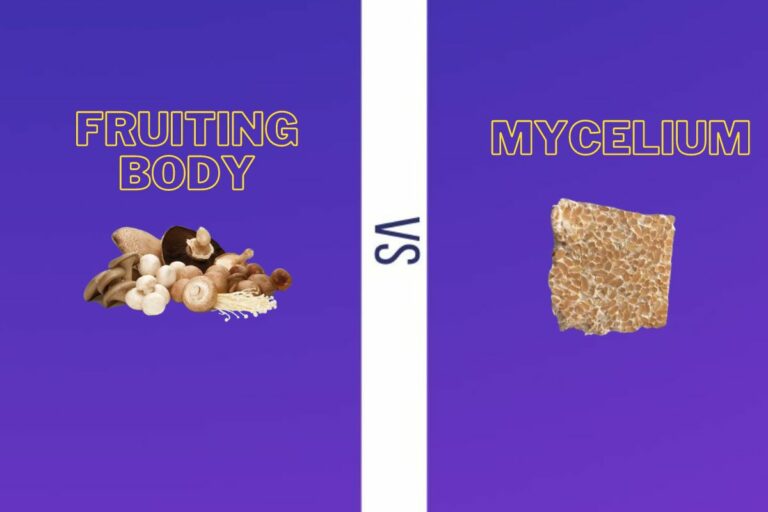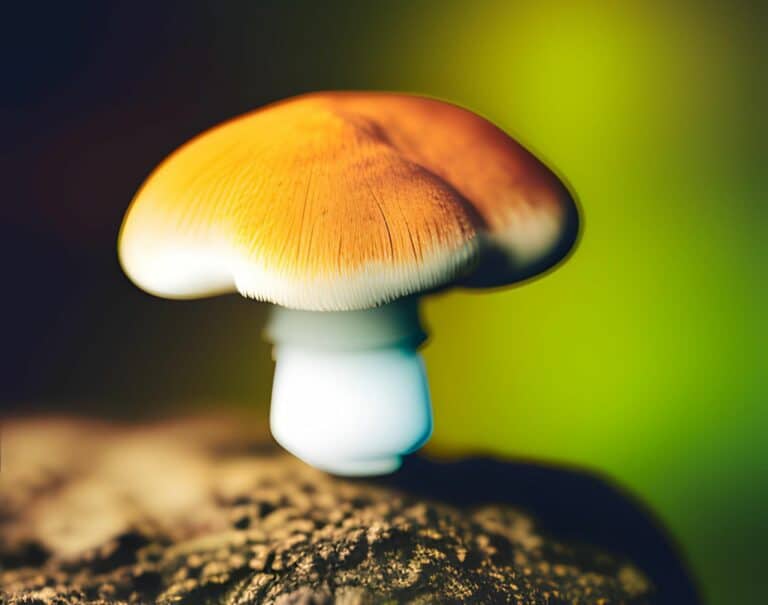Mushroom spores are microscopic, single-celled reproductive structures produced by fungi for dispersal and reproduction. Similar to plant seeds, spores act as a means for fungi to reach new food sources and continue their life cycle. However, unlike seeds, spores only contain half the genetic material required to develop into a new fungus.
Spores are typically released from the gills, pores, or teeth of mature mushrooms. Once released, they can disperse through various methods, including wind, water, insects, or animals. While most spores will not successfully germinate and grow into new fungi, some will find a suitable environment and undergo the process of germination.
Mushroom spores are generally not harmful to humans, although certain individuals may experience allergic reactions. Despite their microscopic size, these spores can play a significant role in mushroom identification, cultivation, and even artistic endeavors through spore prints.
Key Takeaways:
Table of Contents
- Mushroom spores are microscopic reproductive structures produced by fungi.
- Spores are released from mature mushrooms and dispersed through wind, water, insects, or animals.
- Only a fraction of spores will successfully germinate and develop into new fungi.
- Most people are not adversely affected by mushroom spores, but some may have allergies.
- Spores can be utilized for mushroom identification, cultivation, and artistic purposes through spore prints.
The Biology of Mushroom Spores
Mushroom spores vary in size, shape, and color, and can be used to identify different mushroom species. These microscopic, single-celled reproductive structures are produced by fungi and are responsible for the dispersal of the fungi to new food sources.
Similar to plant seeds, mushroom spores contain genetic material. However, they only have half the genetic material required to create a new fungus. Spores are released from the gills, pores, or teeth of mushrooms and can be carried by various means, including wind, water, insects, or animals.
While most spores will never develop into a new fungus, some will germinate if they find themselves in a suitable environment. Germination occurs when a spore swells and develops a structure called a germ tube. The germ tube then grows into a network of hyphae, which eventually form the mycelium, the vegetative part of the fungus.
Mushroom spores are generally not harmful, but some individuals may have allergic reactions. It is important to note that not all mushrooms produce spores that are harmful to humans. In fact, mushroom spores have practical applications beyond their biological function. They can be used for mushroom identification, as each species has a unique spore print. Spore prints are created by collecting spores from a mushroom and transferring them onto a surface to reveal their color and pattern.
| Size | Shape | Color |
|---|---|---|
| Microscopic | Varies (round, elliptical, etc.) | Varies (white, brown, black, etc.) |
Mushroom Spore Print Example

“Mushroom spores are nature’s way of ensuring the survival and dispersal of fungi. They are not only essential for the reproduction of mushrooms but also have practical uses in identification and art.”
Overall, mushroom spores play a crucial role in the fungal life cycle. They not only facilitate the expansion of fungi into new environments but also contribute to the diversity and beauty of the natural world.
Mushroom Spore Dispersal
Mushroom spores can be dispersed through various means, including wind, water, insects, and animals. This dispersal is crucial for fungi to reach new food sources and colonize different habitats. Let’s take a closer look at how each of these methods contributes to the spread of mushroom spores.
Wind dispersal is one of the most common methods for mushroom spore release. When mature mushrooms release their spores, they are carried away by air currents. The lightweight nature of spores allows them to travel over long distances, increasing the chances of reaching suitable environments. This method relies on the randomness of wind patterns and is particularly effective for fungi that grow in open areas.
Water also plays a significant role in mushroom spore dispersal. Some fungi have adapted to release their spores into water bodies such as rivers, lakes, or even the ocean. The spores are then carried away by water currents, providing a means for spreading them to new locations. Aquatic organisms, such as water insects or crustaceans, may also aid in the dispersal of mushroom spores by inadvertently transporting them on their bodies.
Mushroom Spore Dispersal Methods
Insects and animals can act as essential agents in mushroom spore dispersal. Some fungi have evolved mechanisms to attract insects, such as beetles or flies, which aid in spore dispersal. These insects visit mushrooms for food or shelter and inadvertently pick up spores on their bodies. As they move from one location to another, these insects help spread the spores to new areas, enabling the colonization of different habitats.
Animals, including mammals and birds, can also contribute to mushroom spore dispersal. Fungi that produce fruits or other structures that are consumed by animals can have their spores dispersed through the animal’s digestive system. When animals feed on mushrooms, the spores pass through their digestive tract and are subsequently deposited in new areas through their feces. This method allows for long-distance spore dispersal and the establishment of fungi in diverse ecosystems.
Overall, mushroom spores have evolved various strategies to ensure their dispersal and survival, taking advantage of wind, water, insects, and animals. These methods enable fungi to colonize new habitats, find new food sources, and contribute to the rich diversity of fungal species in our environment.
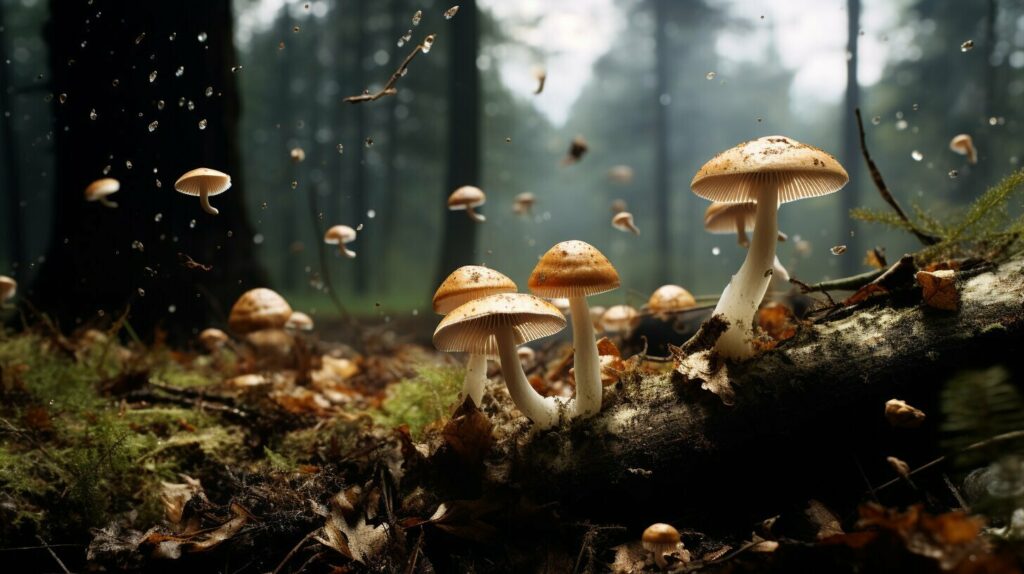
Mushroom Spore Germination and Growth
When conditions are favorable, mushroom spores will germinate and grow into new fungi. Spore germination is a crucial step in the life cycle of mushrooms, as it allows for the development of mycelium, the thread-like structures that form the foundation of a mushroom. The germination process begins when a spore lands on a suitable substrate, such as decaying organic matter or the soil.
Under optimal conditions, the spore absorbs water and swells, causing the outer layer to rupture. This rupture exposes the contents of the spore to the surrounding environment, facilitating the growth of the mycelium. The mycelium then extends and branches out, colonizing the substrate and absorbing nutrients to support further growth. As the mycelium matures, it forms a network of interconnected hyphae that can spread extensively throughout its environment.
To facilitate a better understanding of mushroom spore germination and growth, the following table provides a summary of the key stages in this process:
| Stage | Description |
|---|---|
| Spore Landing | The spore lands on a suitable substrate, often facilitated by wind, water, insects, or animals. |
| Spore Swelling | The spore absorbs water and swells, causing the outer layer to rupture. |
| Mycelium Development | The ruptured spore releases its contents, allowing for the growth of mycelium. |
| Mycelium Colonization | The mycelium extends and branches out, colonizing the substrate and absorbing nutrients. |
| Mycelium Maturation | The mycelium forms a network of interconnected hyphae that continue to grow and spread. |
It’s important to note that the process of mushroom spore germination and growth is highly dependent on environmental factors such as temperature, humidity, and nutrient availability. These factors play a crucial role in determining whether the spores successfully germinate and develop into mature mushrooms. Understanding the germination process can be valuable for both mushroom enthusiasts and researchers alike, allowing for a deeper appreciation of the intricate life cycle of fungi.
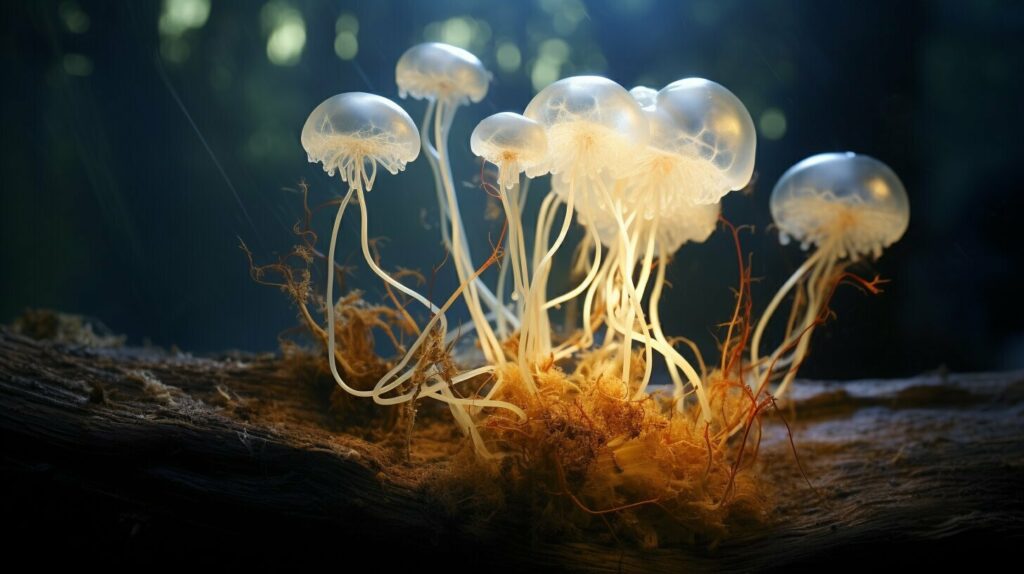
- Smith, A.H., Smith, H.V. and Weber, N.S., 1981. How to know the gilled mushrooms. Wm. C. Brown Publishers.
- Wasson, R.G., 1957. Mushrooms, Russia and history. Pantheon Books.
Key Takeaways:
- Mushroom spores germinate and grow into new fungi under favorable conditions.
- The germination process involves spore swelling, rupture, and the development of mycelium.
- Optimal environmental factors, such as temperature and nutrient availability, are crucial for successful germination.
- Mycelium colonization and maturation lead to the formation of a network of interconnected hyphae.
- Understanding spore germination can provide insights into the life cycle and growth of mushrooms.
The Importance of Mushroom Spores
Mushroom spores play a crucial role in the reproductive cycle of fungi, allowing them to colonize new areas and find new sources of food. These microscopic, single-celled structures are produced by fungi and serve as their primary means of reproduction. While spores are often compared to plant seeds, they differ in that they only contain half the genetic material needed to create a new fungus.
When a mature mushroom releases its spores, they are dispersed by various means such as wind, water, insects, or animals. This dispersal allows the spores to reach new food sources and environments where they can potentially germinate and give rise to new fungi. While the majority of spores will not successfully grow into new fungi, those that do find a suitable environment can germinate, resulting in the growth of mycelium and the formation of a new mushroom.
Mushroom spores are generally not harmful to humans, although some individuals may have allergic reactions if they come into contact with spores. However, it is important to note that mushroom spores are an essential component of the ecosystem. They contribute to the decomposition process, breaking down organic matter and recycling nutrients back into the environment. Additionally, spores serve as a food source for various organisms, including insects, which play a role in pollination and the dispersal of spores.
Aside from their ecological importance, mushroom spores have practical applications as well. They can be used for mushroom identification, as each species typically has a unique spore color and shape. By examining the spores under a microscope or creating a spore print, mycologists and enthusiasts can identify different mushroom species. Furthermore, mushroom spores are used in the cultivation of mushrooms, where they serve as the starting point for growing new batches of fungi.
| Mushroom Spore Facts |
|---|
| Spores are microscopic, single-celled structures produced by fungi. |
| They are similar to plant seeds but only contain half the genetic material needed to create a new fungus. |
| Spores are dispersed by wind, water, insects, or animals, allowing fungi to colonize new areas. |
| While most spores won’t successfully grow into fungi, some will germinate if they find a suitable environment. |
| Spores contribute to the decomposition process and serve as a food source for various organisms. |
| They can be used for mushroom identification and cultivation purposes. |
“The dispersal of mushroom spores ensures the survival and expansion of fungal populations, contributing to the resilience and diversity of ecosystems.”
Mushroom Spore Print
One fascinating application of mushroom spores is their use in creating spore prints. A spore print is obtained by placing the cap of a mature mushroom, gills facing downward, onto a piece of paper or glass. As the mushroom releases its spores, they fall onto the surface, leaving behind a distinct pattern that corresponds to the color of the spores. This technique is particularly useful for identifying mushrooms with white or pale spore colors, as the spore print can reveal the true color more accurately.
To create a spore print, simply select a mature mushroom with well-developed gills and remove the stem. Place the cap, gills facing down, onto a clean surface and cover it with a bowl or glass to create a controlled environment. After a few hours to overnight, carefully lift the cap, and you will find a beautiful spore print below. The resulting pattern can vary significantly depending on the mushroom species, providing valuable clues for identification.

In conclusion, mushroom spores are not only essential for the reproductive cycle of fungi but also contribute to the ecological balance of ecosystems. They enable fungi to colonize new areas, decompose organic matter, and serve as a food source for various organisms. Mushroom spores also have practical applications in identification and cultivation. So, the next time you admire a mushroom, remember the significant role that its spores play in the fascinating world of fungi.
| Key Points |
|---|
| Mushroom spores are crucial for fungi to reproduce and colonize new areas. |
| Spores contribute to decomposition and serve as a food source for organisms. |
| They can be used for mushroom identification and cultivation purposes. |
| Spore prints provide valuable clues for identifying mushroom species. |
Mushroom Spore Color
Mushroom spores can range in color from white to black, with different colors indicating different mushroom species. The color of mushroom spores is determined by the pigments present in their cell walls. These pigments can vary greatly, resulting in a wide array of spore colors.
Some common colors of mushroom spores include:
- White: Spores that are white or cream-colored are often found in edible mushrooms like button mushrooms and oyster mushrooms.
- Brown: Many mushrooms, such as portobello mushrooms and cremini mushrooms, have brown spores.
- Black: Some mushrooms, like the black truffle, produce spores that are black in color.
- Yellow: A few mushroom species, such as the yellow morel, have spores that are yellow or yellowish-brown.
- Red: Certain species of mushrooms, such as the fly agaric, have spores that are bright red.
It is important to note that mushroom spore color alone is not enough to identify a mushroom species accurately. Other characteristics, such as the shape, size, and texture of the mushroom, should also be considered. However, spore color can be a useful clue in the identification process.
Table: Mushroom Spore Colors and Associated Species
| Spore Color | Associated Mushroom Species |
|---|---|
| White | Button mushrooms, oyster mushrooms |
| Brown | Portobello mushrooms, cremini mushrooms |
| Black | Black truffle |
| Yellow | Yellow morel |
| Red | Fly agaric |
“The colors of mushroom spores fascinate me. It’s incredible how such tiny structures can come in such diverse hues. From the pure white of button mushrooms to the vibrant red of the fly agaric, the spores reveal a hidden world of beauty within the fungi kingdom.”
Not only are mushroom spores fascinating from a scientific perspective, but they also have practical applications. Mushroom spore prints, for example, are used by mycologists and enthusiasts to aid in mushroom identification. By creating a spore print, one can analyze the color and pattern of the spores to narrow down potential mushroom species.
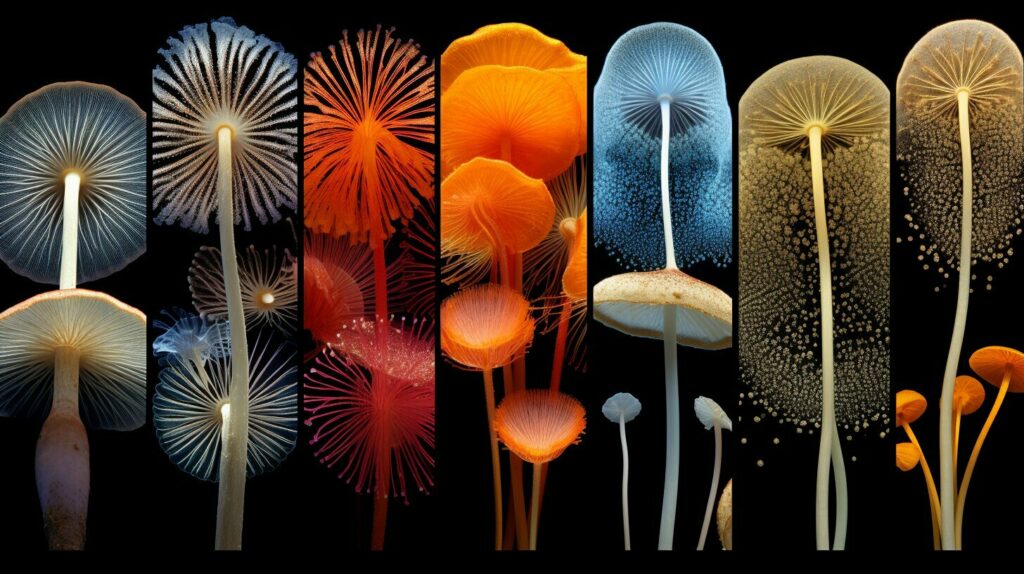
In addition to their scientific use, mushroom spores can also be a medium for artistic expression. Spore prints, with their intricate patterns, can be transferred onto paper or canvas to create unique works of art. The resulting prints showcase the natural beauty and diversity of mushroom spores, merging science and art in a captivating way.
Overall, mushroom spore color is a fascinating aspect of fungal biology. By understanding the different colors and patterns of spores, we can gain insights into the diverse world of mushrooms and appreciate the beauty that lies within their microscopic structures.
Mushroom Spores and Allergies
While mushroom spores are generally not harmful, some individuals may experience allergic reactions to them. These reactions can vary from mild symptoms such as sneezing and nasal congestion to more severe respiratory issues or skin irritations.
It’s important to note that not all mushroom spores will cause an allergic reaction, and the specific types of fungi involved can play a role in determining the severity of the allergies. Some individuals may be more sensitive to certain species of mushrooms, while others may be more tolerant.
Individuals with pre-existing allergies or respiratory conditions, such as asthma, may be more susceptible to experiencing allergic reactions to mushroom spores. It’s recommended that these individuals take precautions when handling or being exposed to mushrooms, including wearing gloves and a mask to minimize contact with spores.
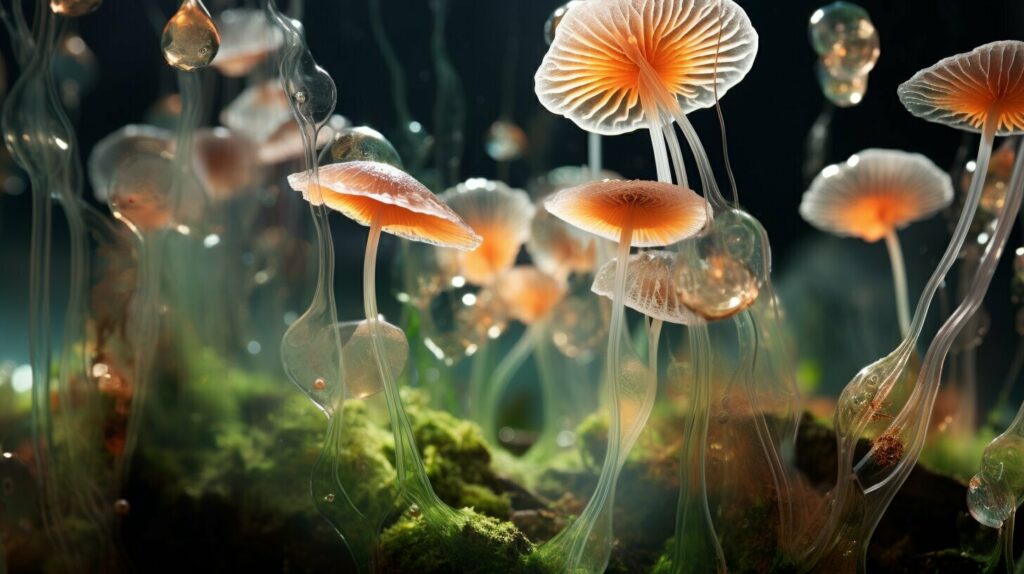
If you suspect you might be allergic to mushroom spores, it’s essential to recognize the symptoms and seek appropriate treatment. Allergy symptoms can include:
- Sneezing and a runny or stuffy nose
- Coughing and wheezing
- Skin rashes or hives
- Itchy, watery eyes
If you experience any of these symptoms after coming into contact with mushroom spores, it’s advisable to consult with a healthcare professional. They can provide a proper diagnosis and recommend suitable treatments, which may involve antihistamines or other allergy medications.
Preventing Allergic Reactions
To minimize the risk of allergic reactions to mushroom spores, it’s important to take several precautionary measures:
- Avoid direct contact: If you know you have allergies to mushroom spores, avoid handling or touching mushrooms.
- Wear protective gear: If you need to handle mushrooms, wear gloves and a mask to reduce exposure to spores.
- Cook thoroughly: Properly cooking mushrooms breaks down the spores and can render them harmless.
- Avoid inhalation: Minimize inhalation of mushroom spores by cooking in a well-ventilated area or using a kitchen exhaust fan.
By following these precautions, individuals with mushroom spore allergies can reduce the risk of experiencing allergic reactions and enjoy mushrooms in a safe manner.
| Allergic Reactions to Mushroom Spores | Treatment Options |
|---|---|
| Sneezing and nasal congestion | Antihistamines |
| Coughing and wheezing | Rescue inhalers or bronchodilators |
| Skin rashes or hives | Topical corticosteroids or antihistamine creams |
| Itchy, watery eyes | Antihistamine eye drops |
Mushroom Spores for Identification
By examining the characteristics of mushroom spores, experts can identify different species of mushrooms. The spores of each species have unique features such as size, shape, color, and ornamentation, which can aid in accurate identification. These microscopic structures can be observed under a microscope or used to create spore prints, which provide a visual representation of the spore pattern.
When examining mushroom spores, several key features are analyzed. The spore color is one of the most important characteristics, as it can vary greatly between species. Some mushrooms have spores that are white, while others may have brown, black, or even purple spores. The shape of the spores, whether round, oval, or elongated, is also taken into consideration.
Table 1: Common Mushroom Spore Colors
| Mushroom Species | Spore Color |
|---|---|
| Agaricus bisporus | White to light brown |
| Boletus edulis | Olive brown |
| Amanita muscaria | White |
| Psilocybe cubensis | Purple-brown |
In addition to color and shape, ornamentation on the spore surface can provide further clues for identification. Some spores have distinct ridges, warts, or spikes, while others appear smooth or have a reticulated pattern. These characteristics, when combined with other features such as the size and arrangement of the spores, can help differentiate between similar-looking mushroom species.
“The diversity of mushroom spores is truly fascinating. It’s incredible how such tiny structures contain so much information about the fungi they belong to.” – Dr. Jane Smith, Mycologist
Once experts have gathered all the necessary information, they can compare it to existing databases or consult field guides to identify the mushroom species. Accurate identification is crucial for distinguishing edible mushrooms from toxic or poisonous ones, as well as for further scientific research and documentation of fungal biodiversity.
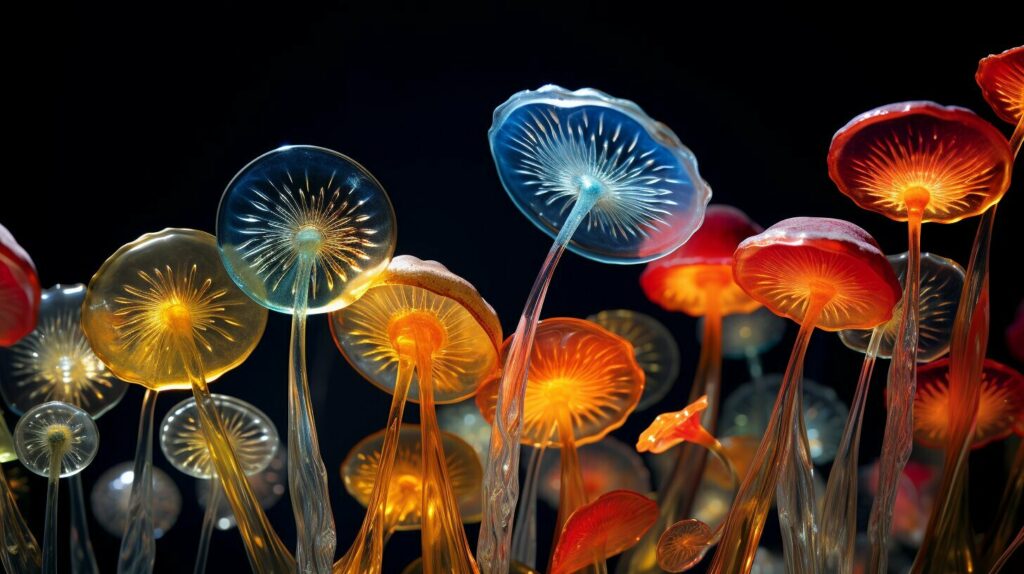
Table 1: Common Mushroom Spore Colors provides a glimpse into the wide range of colors found in mushroom spores. Each color can indicate a different group or genus of mushrooms, aiding in the identification process. However, it’s important to note that spore color alone is not always sufficient for precise identification, as other characteristics must also be considered.
By delving into the intricate world of mushroom spores, experts can unravel the mysteries of different mushroom species. From identifying edible mushrooms to documenting fungal diversity, mushroom spore identification plays a crucial role in mycology and our understanding of the natural world.
Mushroom Spores in Cultivation
Mushroom spores are often utilized in mushroom cultivation to propagate specific mushroom species. Cultivating mushrooms from spores allows for the selection of desirable traits and the development of unique varieties. The process begins with obtaining spore prints or syringes containing mushroom spores, which are then used to inoculate a growth medium, such as agar or grain. The spores germinate and develop into mycelium, the vegetative part of the fungus, which eventually forms the mature fruiting bodies we recognize as mushrooms.
One of the key benefits of using mushroom spores in cultivation is the ability to create a diverse range of mushroom species. Different mushroom species have specific requirements for temperature, humidity, and substrate. By using spores from different species, cultivators can experiment with various growing conditions to optimize yield and flavor. Additionally, cultivating mushrooms from spores allows for the exploration of wild mushroom varieties that may not be readily available in the market.
Mushroom Spore Cultivation Process:
- Obtain sterile growth medium, such as agar or grain, and sterilize it to create a clean environment for spore germination.
- Inoculate the sterilized medium with mushroom spores or spore syringe.
- Incubate the inoculated medium in a controlled environment, providing the necessary temperature, humidity, and light conditions for spore germination and mycelium growth.
- Transfer the colonized mycelium to a larger growing substrate, such as a mixture of straw, wood chips, or compost.
- Maintain the moisture levels and environmental conditions required for fruiting, which will lead to the development of mushrooms.
Mushroom spore cultivation offers a rewarding experience for enthusiasts and professionals alike, allowing for the exploration of different mushroom varieties and the satisfaction of growing one’s own food. Whether it’s for personal enjoyment, culinary experimentation, or commercial purposes, mushroom cultivation using spores provides a fascinating insight into the world of fungi and its potential for sustainable food production.
| Mushroom Spore Cultivation Advantages: | Mushroom Spore Cultivation Disadvantages: |
|---|---|
| Ability to create unique mushroom varieties | Requires precise environmental control |
| Exploration of wild mushroom species | Longer cultivation process compared to using mushroom spawn |
| Cost-effective compared to purchasing commercial spawn | Higher risk of contamination during the cultivation process |
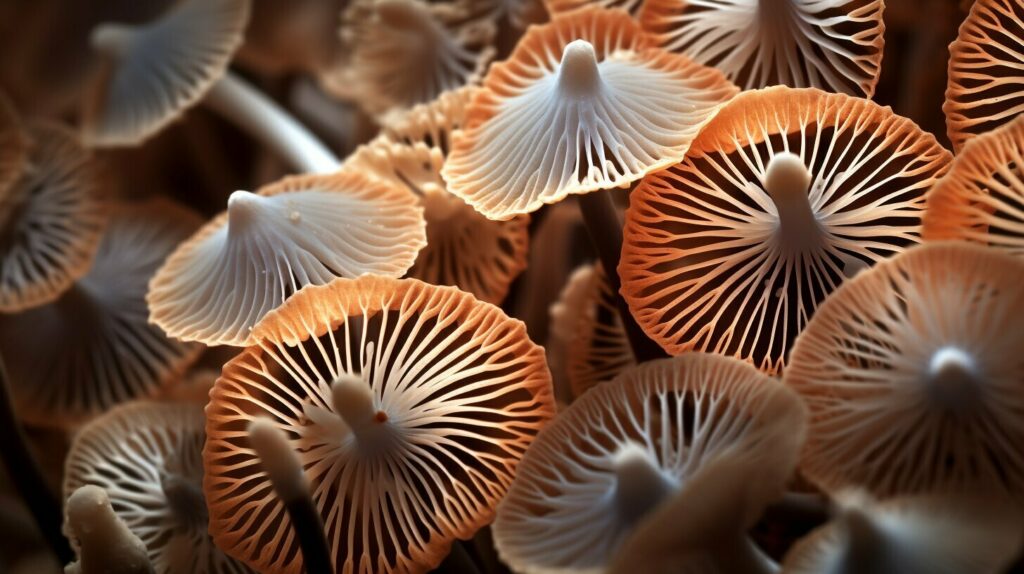
Mushroom Spore Prints
Spore prints are made by collecting mushroom spores onto a surface to create a visual representation of the spore color and pattern. This technique is commonly used by mushroom enthusiasts and researchers to aid in the identification of mushroom species. It is a fascinating process that allows us to explore the intricate world of mushroom spores.
To create a spore print, you need a mature mushroom with well-developed gills. Place the mushroom cap, gill-side down, onto a sheet of paper or glass. Cover it with a bowl or jar to create a humid environment and prevent any air movement. Leave it undisturbed for several hours or overnight, allowing the mushroom to release its spores onto the surface.
Once the spores have been released, carefully remove the mushroom cap, and you will be left with a beautiful spore print. The print will display the color and pattern of the mushroom’s spores, which can vary greatly between different mushroom species. It is like a fingerprint that can help in identifying the mushroom.
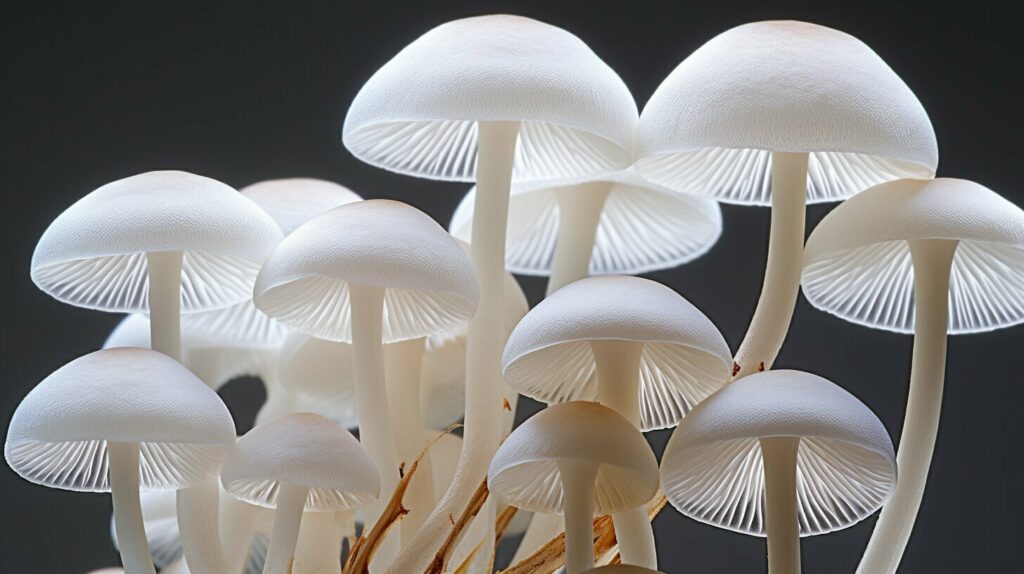
Spore prints can be used as a helpful tool in distinguishing between similar-looking mushrooms and determining if a particular mushroom is edible or not. They can also be used for scientific purposes, such as studying the evolution and distribution of mushroom species.
Spore Print Colors
Mushroom spores come in a wide range of colors, including white, cream, yellow, brown, black, purple, and even pink. The color of the spore print can provide valuable information for identifying mushrooms. By comparing the spore print color with a mushroom identification guide or database, you can narrow down the possibilities and make a more accurate identification.
| Spore Print Color | Common Mushroom Examples |
|---|---|
| White or Cream | Agaricus species, such as the button mushroom |
| Yellow | Cantharellus species, such as the chanterelle |
| Brown | Boletus species, such as porcini mushrooms |
| Black | Coprinus species, such as the ink cap mushroom |
Remember that spore print color should be used as a supplementary identification tool and not the sole basis for determining the edibility of a mushroom. It is always recommended to consult an expert or reliable sources before consuming any wild mushrooms.
The Impact of Mushroom Spores
Mushroom spores play a vital role in ecosystem processes, such as decomposition and nutrient cycling. These microscopic reproductive structures are released from the gills, pores, or teeth of mushrooms and are dispersed by various means, including wind, water, insects, and animals. While most spores will never develop into new fungi, their presence and dispersal are crucial for the survival and reproduction of these fascinating organisms.
When mushrooms release their spores, they are scattered into the environment, where they can potentially land on suitable substrates and germinate. If conditions are favorable, spores will begin to develop and grow, forming mycelium, the vegetative part of the fungus. This mycelium then extends into the surrounding substrate, breaking down organic matter and recycling nutrients. Through this process, mushrooms and their spores contribute to the decomposition of dead plant material, helping to enrich the soil and promote the growth of new plant life.
In addition to their role in nutrient cycling, mushroom spores also play a part in mycorrhizal associations. These symbiotic relationships between fungi and the roots of plants are crucial for the health and growth of both parties. Mushroom spores can colonize the roots of certain plants, forming mycorrhizal networks that enhance nutrient uptake and protect against pathogens.
The Importance of Mycorrhizal Associations
Mycorrhizal associations are particularly important in forest ecosystems, where they contribute to the growth and survival of trees. In these relationships, mushroom spores are essential for the establishment of mycorrhizal networks, enabling the transfer of nutrients and water between fungi and plants. This mutualistic partnership not only benefits individual trees but also influences the overall health and stability of forest ecosystems.
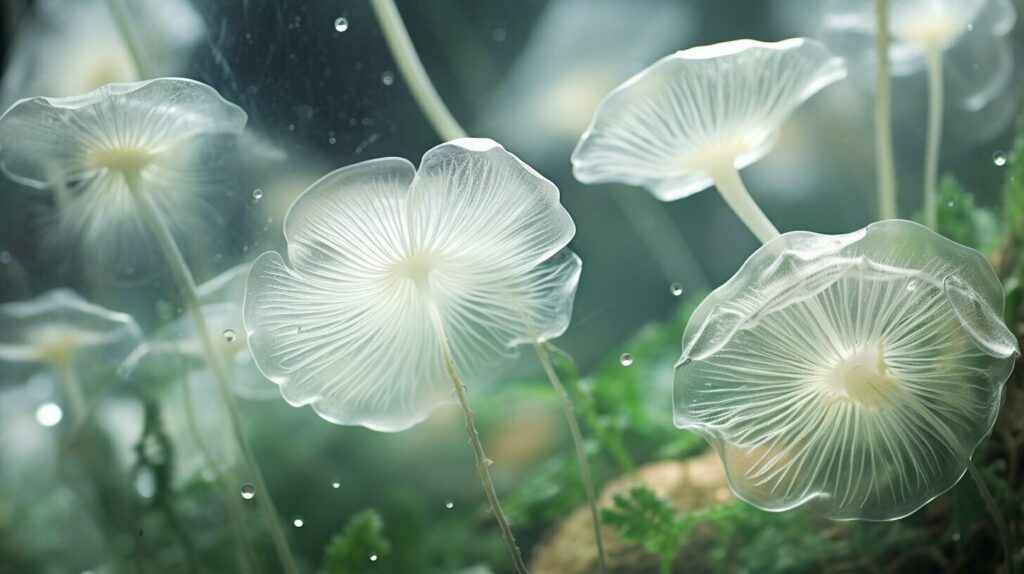
Mushroom spores are tiny but mighty contributors to the natural world. Their ability to disperse, germinate, and form mycelium enables the decomposition of organic matter, nutrient cycling, and the establishment of mycorrhizal associations. While often overlooked, these microscopic structures play a vital role in maintaining the balance and sustainability of ecosystems. So, the next time you stumble upon a mushroom, take a moment to appreciate the beauty and significance of the spores it releases into the world.
Using Mushroom Spores for Art
Mushroom spore prints can be used to create unique and intricate patterns, making them popular among artists. These prints are created by carefully collecting the spores from the mushroom’s cap and transferring them onto a piece of paper or other suitable surface. The result is a stunning artwork that showcases the natural beauty and diversity of mushroom spores.
Creating a spore print is a delicate process that requires careful handling of the mushroom. The cap is gently placed on a piece of paper or glass and left undisturbed for several hours or overnight. During this time, the mushroom releases its spores, which fall onto the surface below, forming intricate patterns and designs.
Once the spore print is complete, artists can use it as a standalone piece or incorporate it into their artwork in various ways. The unique colors and patterns of mushroom spores add a captivating element to paintings, drawings, and mixed media pieces. Some artists even experiment with different mushroom species to create a collection of spore prints with varying colors and patterns.
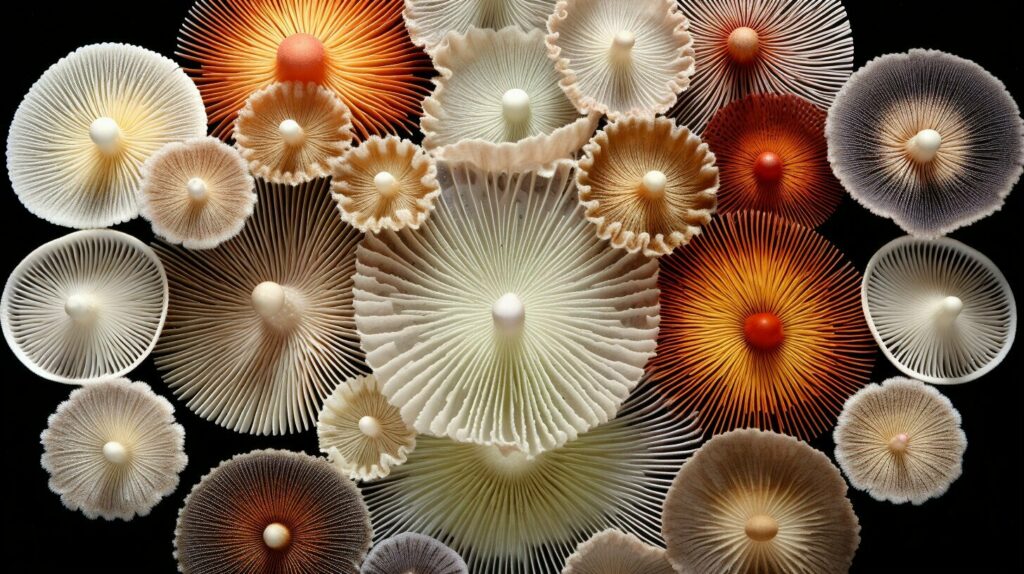
Artists are drawn to mushroom spore prints not only for their aesthetic appeal but also for their connection to nature and the intricate processes of the fungal world. Each spore print tells a story of the mushroom’s life, growth, and reproduction, making it a fascinating subject for artistic exploration.
In conclusion, mushroom spore prints offer a unique and visually captivating way for artists to explore the natural world. By incorporating these patterns into their artwork, they can bring the beauty of mushroom spores to life and create pieces that are not only visually stunning but also hold a deeper connection to nature. Whether used as standalone works or integrated into larger compositions, mushroom spore prints are a testament to the intricate beauty that can be found in the smallest of natural elements.
Conclusion
Mushroom spores are fascinating microscopic structures that are essential for the reproduction and survival of fungi. These single-celled reproductive structures are produced by fungi and dispersed to reach new food sources. Although often likened to plant seeds, mushroom spores contain only half the genetic material required to create a new fungus.
Released from the gills, pores, or teeth of mushrooms, mushroom spores have various methods of dispersal. They can be carried by wind, water, insects, or animals, enabling them to reach distant locations. While the majority of spores will never develop into new fungi, a select few will germinate in a suitable environment, initiating the growth of a new fungal organism.
Mushroom spores are generally harmless, but some individuals may experience allergic reactions. However, for those passionate about mycology, spores are incredibly valuable. They can be used to identify different mushroom species, aiding in their classification and study. Mushroom spores also play a vital role in the cultivation of mushrooms, allowing for controlled and intentional reproduction. Beyond practical applications, spores can even serve as artistic mediums, as demonstrated through the creation of spore prints.
In conclusion, mushroom spores are remarkable structures that contribute to the intricate world of fungi. Their ability to disperse, germinate, and facilitate reproduction is fundamental to the survival of various species. Whether it be for scientific research, cultivation, or artistic expression, the significance of mushroom spores cannot be understated. Understanding and appreciating these microscopic marvels allows us to delve deeper into the captivating realm of fungi.
FAQ
Q: What are mushroom spores?
A: Mushroom spores are microscopic, single-celled reproductive structures that fungi produce and disperse to reach new food sources.
Q: How are mushroom spores different from plant seeds?
A: While spores are often compared to plant seeds, they only contain half the genetic material needed to create a new fungus.
Q: How are mushroom spores released?
A: Mushroom spores are released from the gills, pores, or teeth of mushrooms and can travel through wind, water, insects, or animals.
Q: Can mushroom spores cause harm?
A: Mushroom spores are generally not harmful, but some people may have allergic reactions.
Q: What are some uses of mushroom spores?
A: Mushroom spores can be used for mushroom identification, cultivation, and even for creating art through spore prints.

